CALIFORNIA SHORT-TAILED ALBATROSSES
a summary at the turn of the 21st century
a web discussion by Don Roberson
The Short-tailed Albatross Phoebastria albatrus* once bred in huge
numbers on at least eleven uninhabited remote islands in subtropical waters
west of the Izu-Bonin islands chain, south of Japan. These long-lived birds
do not reach full maturity until about 12 years old; away from the breeding
islands they ranged widely throughout the north Pacific Ocean (Hasegawa
1984). Here in California, it was once considered “fairly common at sea,
irrespective of season” and thought to be the commonest albatross inshore
as indicated by the predominance of its bones in certain shellmounds, such
as at Pt. Mugu, Ventura Co. (Grinnell & Miller 1994). Short-tailed
Albatross (formerly called “Steller’s Albatross”) was considered "common"
in Monterey Bay in the fall/winter of 1894-1896 and was often seen from
shore (Loomis 1896-1900).
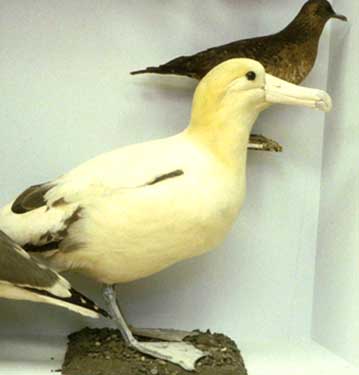 A
number of California specimens were taken in this period, presumably including
the mounted adult (right; photo © Gary Lester) from the Clarke
collection, now at Eureka High School, Humboldt Co. (no data with specimen).
Grinnell & Miller (1944) give the last specimen as 3 Apr 1898 at San
Pedro, Los Angeles Co. It was then last reported in the field from Pt.
Pinos, Monterey Co., by R. H. Beck on 12 Dec 1904, when he saw an albatross
"that might have been this species" (Beck 1910).
A
number of California specimens were taken in this period, presumably including
the mounted adult (right; photo © Gary Lester) from the Clarke
collection, now at Eureka High School, Humboldt Co. (no data with specimen).
Grinnell & Miller (1944) give the last specimen as 3 Apr 1898 at San
Pedro, Los Angeles Co. It was then last reported in the field from Pt.
Pinos, Monterey Co., by R. H. Beck on 12 Dec 1904, when he saw an albatross
"that might have been this species" (Beck 1910).
At the turn of the 20th century, the species was almost extirpated by
plume hunters on its volcanic nesting islands. It has been estimated that
5 million albatross were killed here from 1887-1902 until a volcano in
1902 wiped out the village of the plume hunters (Harrison 1979). Many thought
it extinct by World War II (Austin 1949). But a tiny colony was discovered
in 1951 on the volcanic ash slopes of Torishima in the Izu Islands. Under
conservation efforts by the staff of a small meteorological station there,
numbers grew. Adult numbers reached 50 by 1965 and to 130 by 1978; young
were produced each year since 1960 (up to about 25 young fledged by 1980;
Hasegawa 1984). A second small colony on an inaccessible cliff ledge on
Minami-kojima in the Senkaku Island was found in 1979, and breeding confirmed
in 1988 (population of 75 birds and 15 breeding pairs in 1991; Hasegawa
1991). The most recent estimate is apparently about 500 adults and perhaps
1100 birds in all (U.S. gov’t estimate 1999). One-two birds have been present
off-and-on at Midway Island for two decades, with a single incubating individual
found in November 1993, but the egg didn’t hatch (Harrison et al. 1984,
Richardson 1994). On Torishima, nesting conditions have been improved by
planting native grass to stabilize breeding sites; active banding operations
began within the last decade.
With increases in population, this huge albatross was expected to return
to its former range. These are the modern records for California:
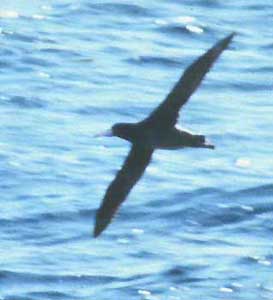
1. 28 Aug 1977, about 90 mi. west of San Diego, Keith C. Richards
saw an all-dark immature with Black-footed Albatross P. nigripes
but “appreciably larger .. and had a heavy-looking bill” (Unitt 1984).
This bird was not photographed, nor do we have an exact location. Ninety
miles west of San Diego is closer to San Nicolas I., Ventura Co., than
any other point of land.
2. 2 Dec 1983, first sighted at 35°30'N, 122°11'W, off
Pt. Piedras Blancas, San Luis Obispo Co. This all-dark immature followed
the research ship Bob Pitman was on for nearly an hour and into Monterey
Co. waters at a point about 60 nmi. SW of Cape San Martin. This bird was
photographed (right; © R.L. Pitman) and appears to be in juvenal
plumage. Although it is difficult to say for sure, there do not appear
to be any signs of molt in the remiges and thus is seems likely the bird
was in its first year of life.
3. 3-5 Nov 1985 over Cordell Bank, Marin Co. Rich Stallcup discovered
this juvenal-plumaged bird from a chartered boat where it came into popcorn
(Stallcup 1990); a “chase” trip organized two days later refound it (but
another “chase” two days after that did not).
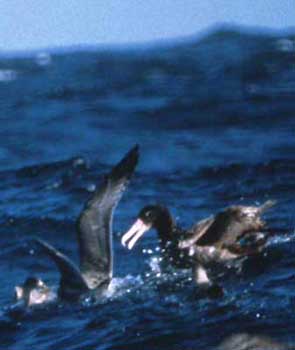 Photographs
have appeared widely; one of my 5 Nov photos is shown (right; ©
D. Roberson) and another is on my Albatross
page. Close examination of some photos showed it to be banded, presumably
as a fledgling on Torishima, Japan. It had an all-pink bill without a bluish
or dark tip. I also like this photo because it gives one a sense of just
how rough the sea was the day of the first "chase" trip.
Photographs
have appeared widely; one of my 5 Nov photos is shown (right; ©
D. Roberson) and another is on my Albatross
page. Close examination of some photos showed it to be banded, presumably
as a fledgling on Torishima, Japan. It had an all-pink bill without a bluish
or dark tip. I also like this photo because it gives one a sense of just
how rough the sea was the day of the first "chase" trip.
4. 18 Apr 1987 about 20 nmi. W of Cypress Pt., Monterey Co. Another
all-dark immature was seen by David G. Ainley but it was not photographed.
[Also, just beyond the 200 nautical mile limit we use for California
waters, yet another youngster seen by Peter Pyle from a research ship about
270 mi SW of Pt. Sur, Monterey Co. “was picking at a dead giant squid”
(Stallcup 1990).]
5. 28 Aug 1998 about 20 nmi W of Bodega Head, Sonoma Co. All
all-dark juvenal-plumaged bird, also banded, was photographed by Guy Luneau,
Dan W. Nelson, and others. Nelson’s photo is on-line on Joe
Morlan’s web site. It appears have an all-pink bill without any hint
of a bluish or dark tip, and is in wing molt. Thus it should be older than
one year.
6. 26 Oct 1998 over Cordell Bank, Marin Co. A fresh-plumaged
juvenal bird whose pink-bill has a bluish tip (and thus clearly not the
August bird in the same area) was photographed by Bert McKee and others.
McKee’s photos are on-line on Joe
Morlan’s web site.
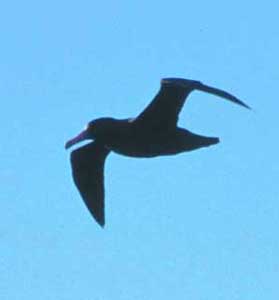 7.
21 Dec 1998 in Monterey Bay just over 3 mi WNW of Pt. Pinos, Monterey Co.
Found by Steve Howell & Richard Ternullo, Richard’s photo is shown
(right; © R. Ternullo). It was a fresh-plumaged juvenal bird
whose pink bill has a bluish tip.
7.
21 Dec 1998 in Monterey Bay just over 3 mi WNW of Pt. Pinos, Monterey Co.
Found by Steve Howell & Richard Ternullo, Richard’s photo is shown
(right; © R. Ternullo). It was a fresh-plumaged juvenal bird
whose pink bill has a bluish tip.
8. 1-10 May 1999 from shore between Pebble Beach and Pt Pinos,
Monterey Co. This all-dark pink-billed bird was scoped from shore during
during high winds which pushed many Black-footed Albatross close to shore
each afternoon, permitting comparison. First found by Craig Hohenberger
and others on 1 May, it was seen again on 9 May & 10 May (details on
my ID of silhouetted
dark albatross page). This was the first Short-tailed Albatross seen
from shore in 95 years.
9. 7 Aug 1999 about 15 nmi. W of Cypress Pt., Monterey Co. Seen
on a chartered boat trip that included Ryan Chornock, Bert McKee, &
Debi Shearwater, it was photographed by several, including a video by Les
Lieurance that is on Joe
Morlan's web site.
10. 8 Jan 2000 over Cordell Bank, Marin Co. An all-dark juvenal
from a chartered boat trip by Dan Nelson and others. Here are two photos
(below; @ Dan Nelson) of that bird; Dan's lefthand photo is a remarkable
"three albatross" shot!
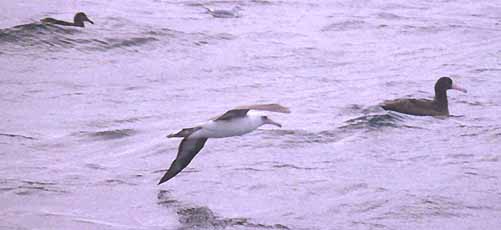

 11.
15 Jan 2000 about 26 nmi. WSW of Pt. Buchon, San Luis Obispo Co. This fresh-plumaged
juvenal, showing a pink bill with a bluish tip, was first found by me (Don
Roberson) and Tom Edell. It showed no signs of any wing or tail molt; a
photo is shown (right; © 2000 Norwood C. Hazard). The location
was over the Santa Lucia Escarpment, an upwelling site that attracts albatross.
On this trip we had the completely unique experience of seeing only three
albatross: one each of three different species! [Short-tailed, Black-footed,
Laysan].
11.
15 Jan 2000 about 26 nmi. WSW of Pt. Buchon, San Luis Obispo Co. This fresh-plumaged
juvenal, showing a pink bill with a bluish tip, was first found by me (Don
Roberson) and Tom Edell. It showed no signs of any wing or tail molt; a
photo is shown (right; © 2000 Norwood C. Hazard). The location
was over the Santa Lucia Escarpment, an upwelling site that attracts albatross.
On this trip we had the completely unique experience of seeing only three
albatross: one each of three different species! [Short-tailed, Black-footed,
Laysan].
With now ten recent sightings, half of them within the last 13 months,
we can look forward to additional sightings in the future. All recent observations
have been of all-dark immatures; all those photographed prove to have been
in juvenal plumage. There has been slight variation in bill color at the
tip of the bill, but the huge long bright pink bill dominates one’s first
impression of this great bird.
Observers should be aware that some old or pale Black-footed Albatrosses
can have pinkish bills and have been mistaken as this species. One photographed
20 Apr 1978 about 50 miles WNW of the Monterey Peninsula was published
as a “Short-tailed” (Helm 1980) was later proven to be misidentified (Roberson
1980). Identification criteria is given in Roberson (1980) and to some
extent on my ID
of silhouetted dark albatross page. The very heavy and long bill is
a critical point in addition to its color.
Some albatross species retain juvenal remiges for a year or more (Murphy
1936); I have as yet been unable to determine when Short-tailed Albatross
begins post-juvenal molt. It may be that such young birds wander the most
widely. It may be that the first post-juvenal plumage is all-dark or mostly
dark, but such birds should be in wing molt which presumably occurs year-round
until suspended during nesting many years later. Hasegawa’s photo of an
almost-all-dark immature in Harrison (1987) show a bird in primary molt
and with slight pale whitish patches beginning in the center of the greater
secondary coverts along with a bit of white in the face. Roberson (1980)
sketches an approximate plumage sequence based on Japanese literature,
and this general sequence is followed in Harrison (1983). Details of recent
Alaskan observations, including photos of immature birds older than juvenal
birds, is on line
HERE.
It is also noted that a sighting from 17 Feb 1946 about 70 mi. w. Pt.
Año Nuevo, San Mateo Co., was published as a “Short-tailed” (Traylor
1950). This was a white albatross (and thus an adult Short-tailed if correct)
but published details did not eliminate several species of mostly white
albatross from the South Pacific (and there are North Pacific records of
Shy Diomedea cauta and Wandering D. exulans albatrosses which
now need to be considered).
* = Nearly all the literature uses Diomedea albatrus for Short-tailed
Albatross, but the 7th ed. A.O.U. Check-list (1998) resurrected Phoebastria
Reichenbach for the three North Pacific albatross.
Literature cited:
Austin, O. L., Jr. 1949. The status of Steller’s Albatross.
Pacific Sci. 3: 283-295.
Beck, R. H. 1910. Water birds of the vicinity of Point Pinos, California.
Proc. Cal. Acad. Sci., 4th ser. 3: 57-72.
Grinnell, J., and A. H. Miller. 1944. Distribution of the Birds of California.
Pac. Coast Avifauna 27.
Harrison, C. 1979. Short-tailed Albatross. Oceans 12 (5): 24-27.
Harrison, C. S., M. G. Naughton, and S. I. Fefer. 1984. "The status
and conservation of seabirds in the Hawaiian Archipelago and Johnston Atoll"
in
Status and Conservation of the World's Seabirds (J. P. Croxall, P.
G. H. Evans, and R. W. Schreiber, eds.). Internat. Council for Bird Preservation,
Tech. Publ. 2.
Harrison, P. 1983. Seabirds: an Identification Guide. Boston: Houghton
Mifflin.
Harrison, P. 1986. Seabirds of the World: A Photographic Guide. London,
Christopher Helm. [Published in the U.S. as Field Guide to the Seabirds
of the World, Lexington, MA.: Stephen Greene Press]
Hasegawa, H. 1984. "Status and conservation of seabirds in Japan, with
special attention to the Short-tailed Albatross" in Status and Conservation
of the World's Seabirds, J. P. Croxall, P.G.H. Evans, and R. W. Schreiber,
eds. ICBP Tech. Pub. 2.
Hasegawa, H. 1991. Red Data Birds: Short-tailed Albatross. World Birdwatch
13(2): 10.
Helm, R. C. 1980. A Short-tailed Albatross off California.
West. Birds 11:47-48.
Loomis, L. M. 1896-1900. California Water Birds: Monterey and vicinity.
Nos 1-2 & 4-5. Proc. Calif. Acad. Sci., 2nd series 5: 177-224; 6: 1-30;
3rd series 2: 277-322; 2: 349-363.
Murphy, R. C. 1936. Oceanic Birds of South America. Vol. 1. Amer. Mus.
Nat. Hist., New York.
Richardson, S. A. 1994. Status of the Short-tailed Albatross on Midway
Atoll. ‘Elepaio 54.
Roberson, D. 1980. Rare Birds of the West Coast of North America. Woodcock
Publ., Pacific Grove CA.
Stallcup, R. 1990. Ocean Birds of the Nearshore Pacific. Pt. Reyes Bird
Obs., Stinson Beach, CA.
Traylor, M. A. 1950. A record of the Short-tailed Albatross. Condor
52: 90.
Unitt, P. 1984. The birds of San Diego County. San Diego Soc. Nat. Hist.
Memoir 13.
TOP
GO TO LIST
OF FAMILIES OF THE WORLD
GO TO ALBATROSS
FAMILY PAGE
RETURN
TO IDENTIFICATION PAGE
GO TO HOME PAGE
GO TO BIRDING THE
WORLD
Page created 25-26 Jan 2000; updated with add'l photos
26 May 2000

 A
number of California specimens were taken in this period, presumably including
the mounted adult (right; photo © Gary Lester) from the Clarke
collection, now at Eureka High School, Humboldt Co. (no data with specimen).
Grinnell & Miller (1944) give the last specimen as 3 Apr 1898 at San
Pedro, Los Angeles Co. It was then last reported in the field from Pt.
Pinos, Monterey Co., by R. H. Beck on 12 Dec 1904, when he saw an albatross
"that might have been this species" (Beck 1910).
A
number of California specimens were taken in this period, presumably including
the mounted adult (right; photo © Gary Lester) from the Clarke
collection, now at Eureka High School, Humboldt Co. (no data with specimen).
Grinnell & Miller (1944) give the last specimen as 3 Apr 1898 at San
Pedro, Los Angeles Co. It was then last reported in the field from Pt.
Pinos, Monterey Co., by R. H. Beck on 12 Dec 1904, when he saw an albatross
"that might have been this species" (Beck 1910).
 Photographs
have appeared widely; one of my 5 Nov photos is shown (right; ©
D. Roberson) and another is on my
Photographs
have appeared widely; one of my 5 Nov photos is shown (right; ©
D. Roberson) and another is on my  7.
21 Dec 1998 in Monterey Bay just over 3 mi WNW of Pt. Pinos, Monterey Co.
Found by Steve Howell & Richard Ternullo, Richard’s photo is shown
(right; © R. Ternullo). It was a fresh-plumaged juvenal bird
whose pink bill has a bluish tip.
7.
21 Dec 1998 in Monterey Bay just over 3 mi WNW of Pt. Pinos, Monterey Co.
Found by Steve Howell & Richard Ternullo, Richard’s photo is shown
(right; © R. Ternullo). It was a fresh-plumaged juvenal bird
whose pink bill has a bluish tip.

